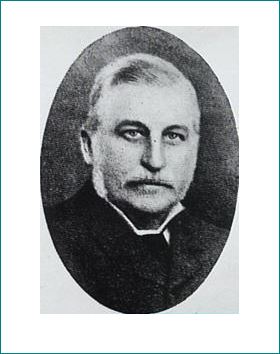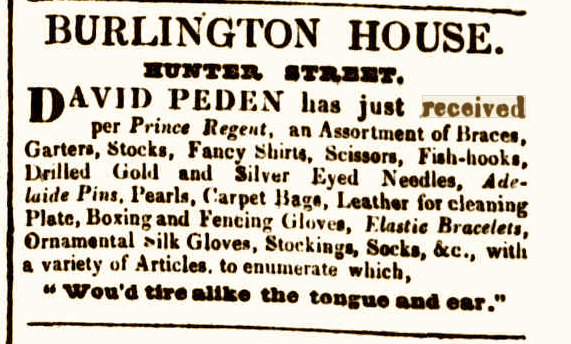When Randwick became a Municipality in February 1859, the six men who had been elected decided to be known as Councillors, with a Chairman rather than a Mayor as leader. It was not until nine years later, in 1868, that the second (1867) Municipalities Act had prompted many Councils, including Randwick’s, to revert to the more traditional titles of Aldermen and Mayor. So strictly speaking, Randwick did not have a Mayor until February 1868.
During the first nine years, there were only three Chairmen; John Dawson of ‘Burnside’, Avoca St., (served for 4 terms), Charles Moore of Coogee (1 year in 1863), & Simeon Henry Pearce (also 4 terms). Furthermore, all three men were immigrants, although all had married Colonial-born ladies. In 1868, Simeon Pearce was unanimously elected for a fifth term of Council leadership, and so became Randwick’s first officially designated Mayor.
However, the next year, in 1869, Randwick finally acquired its first wholly Australian couple as Mayor and Mayoress – Magnus Jackson Peden and his wife Elizabeth Neathway, nèe Brown.
Magnus was 34 at the time, having been born on 21st August 1834 in Hunter Street, Sydney, where his parents David and Sarah (nèe Topham) Peden had opened a drapery shop after arriving in NSW in 1833.
Elizabeth Neathway Brown, as Randwick’s second Mayoress, was not only Colonial-born but a local girl, being the third child of John Neathway Brown and Caroline Cook (nèe Cubitt) Brown, and the first, on 27th April 1836, of the nine little Neathway Browns to be born at Bunnerong House. This large stone-built house had been built on the northern shores of Botany Bay in about 1835 – the name “Boonerong” being an indigenous native one for the area, and one that her father had chosen to perpetuate when he acquired his 100 acres there – although in his (very articulate) letters to newspapers & Government officials he spelt it ‘Bunarong’.
Magnus and Elizabeth had married in 1861, and lived first ‘over the shop’ which Magnus had established at the south-east corner of George and Park Streets. As Magnus’ specialty was groceries, it is appropriate that this area is now occupied by Woolworth’s food store opposite the Sydney Town Hall – although at that time it was opposite the overgrown Old Burial Ground, so not quite so desirable! Then, after a year at Manly, by 1864 they were living in Waverley and on 11th March 1865 purchased at auction the estate later known as Nugal Hall *, on the eastern side of Avoca Street, Randwick – being the highest bidders at £700.
Magnus soon involved himself in local affairs, being elected on 15th February 1866 as one of Randwick’s six Councillors, (as they were still then called) – the other five being Samuel Hebblewhite of Brisbane Villa (site of Marcellin College), Charles Moore, Simeon Pearce and his brother James, and John Watkins who built Aston Hall, now part of Emanuel School on Stanley Street.
Magnus was no stranger to Council politics, as his father David had been elected to the first ill-fated Sydney Council (1842 – 1853) in 1849, and served until the Government abolished it in December 1853. (At which time, John Rae was appointed as one of the first Sydney City Commissioners – his name is commemorated by Rae Street, Randwick, which runs through the land he bought in 1855 from the initial Crown land purchaser, John Woods.)
During Peden’s first year as a Councillor, apart from the usual issues of upgrading dirt tracks into roads and disposing of nightsoil, the members agreed to provide the first public fountain at the top of the long haul up the Sydney Road (Alison Road). After advertising for designs and tenders, in May 1866 the Council accepted that of sculptor, Walter McGill. In early November, “on a beautiful day tempered by Randwick’s famous ocean breezes”, and witnessed by an appreciative crowd, the St. Jude’s Fountain was dedicated by John Dawson – the instigator, with his brother Edward, of the original idea. As the fountain was still lacking a pump, he poured a bottle of water over it instead, the purchase of pump and pipes having been deferred to the next year’s Council budget…
In 1869, after being re-elected for a third year, now as an Alderman, at the next Council meeting on the 5th February, Peden was nominated by Simeon Pearce for the Mayoral seat, which was carried unanimously. As the new Mayor, his very first proposal (which was approved at a cost of £300) was the surfacing of Power and Nathan Streets (Carrington Road), from “the entrance of Bishopscourt to Whale Street” (Coogee Bay Road). This was a very diplomatic move, as this road lies just between Randwick and Coogee; the latter district being still restless following the failure of its bid to become a Municipality in its own right, due to the qualifying limitations of land area and population set by the 1867 Act.
Unfortunately I have found no reference to Elizabeth’s activities as Mayoress, probably because in June of that Mayoral year the Peden’s fifth child and first son, Alexander David, was born, so there would have been maternal preoccupations – genteel ladies in an ‘interesting condition’ in that era were not expected to take part in any social activities other than private family ones.
Magnus Peden resigned from the Council towards the end of his fifth term, in November 1870. By then he had been appointed as a JP for Randwick, and in 1873 was engaged as a Council valuer. In May 1873 the Pedens sold the ‘Nugal Hall’ estate to James Mennie Tarves, a surveyor, for £920, who in turn, just five months later, sold it on to the Budd family – William, Annie and daughters, most of whom had been given the names of flowers…
In early 1874 the Pedens left the Sydney area, literally for ‘pastures new’, as Magnus took up farming in the Bega district, although he did also run a large store in the town. He became that district’s Coroner for many years, and also resumed his interest in Municipal affairs, being Mayor of Bega in 1887. But their time in the Randwick area was not forgotten, as among the homes the Peden family built near Bega in later years was one they called ‘Bunnerong Cottage’.
Epilogue; The Peden’s had nine children, although two died in infancy. In 1889 Magnus & Elizabeth moved back to Sydney, residing in present day Cremorne. Magnus died in 1901 and Elizabeth in 1913 – both were buried at the Gore Hill cemetery, North Sydney.
~~~~~~~~~~~~~~~~~~~~~~~~~~~~
* The name ‘Nugal’ first appears in an advertisement in the Sydney Morning Herald in early 1884, and in Sands Directory for that year [1885 Edition], when the owner /occupant at ‘Nugal Lodge’ was Frederick W Ricketson, a grazier from Canada. Prior to that, the property was owned by Joseph Barling, who called it ‘Branksea’, after a castle near his birthplace at Poole, Dorset.
In 1870, Sands Directory [Sands 1871 Edition] lists the Pedens at ‘Rockville’, Randwick – the Randwick rates indicate that they had not ‘moved house’ that year, so they might have been using that name for the property at that time. However, as that year is the only time during their occupancy that a house name was listed, it may have been an error printed by Sands or supplied by Sands’ agent.
Sources for this article include Randwick Council Minutes and Rates, the Peden Papers held by the Mitchell Library, Land Registry records, and R&DHS Archives.




